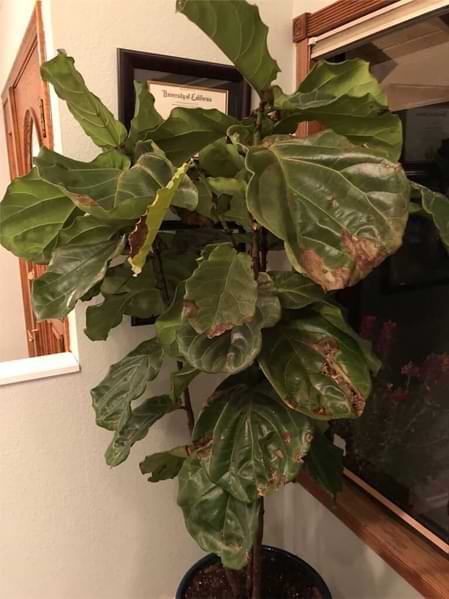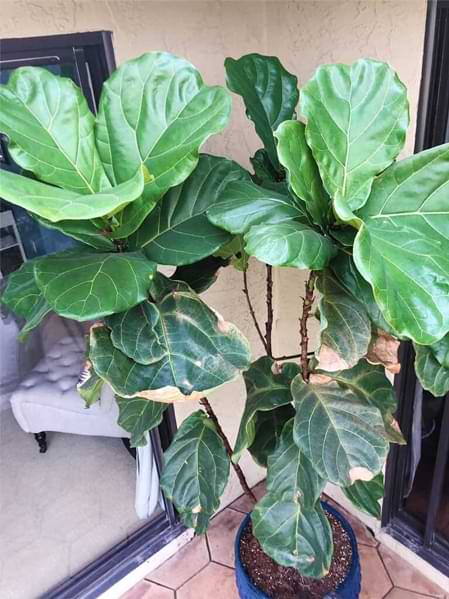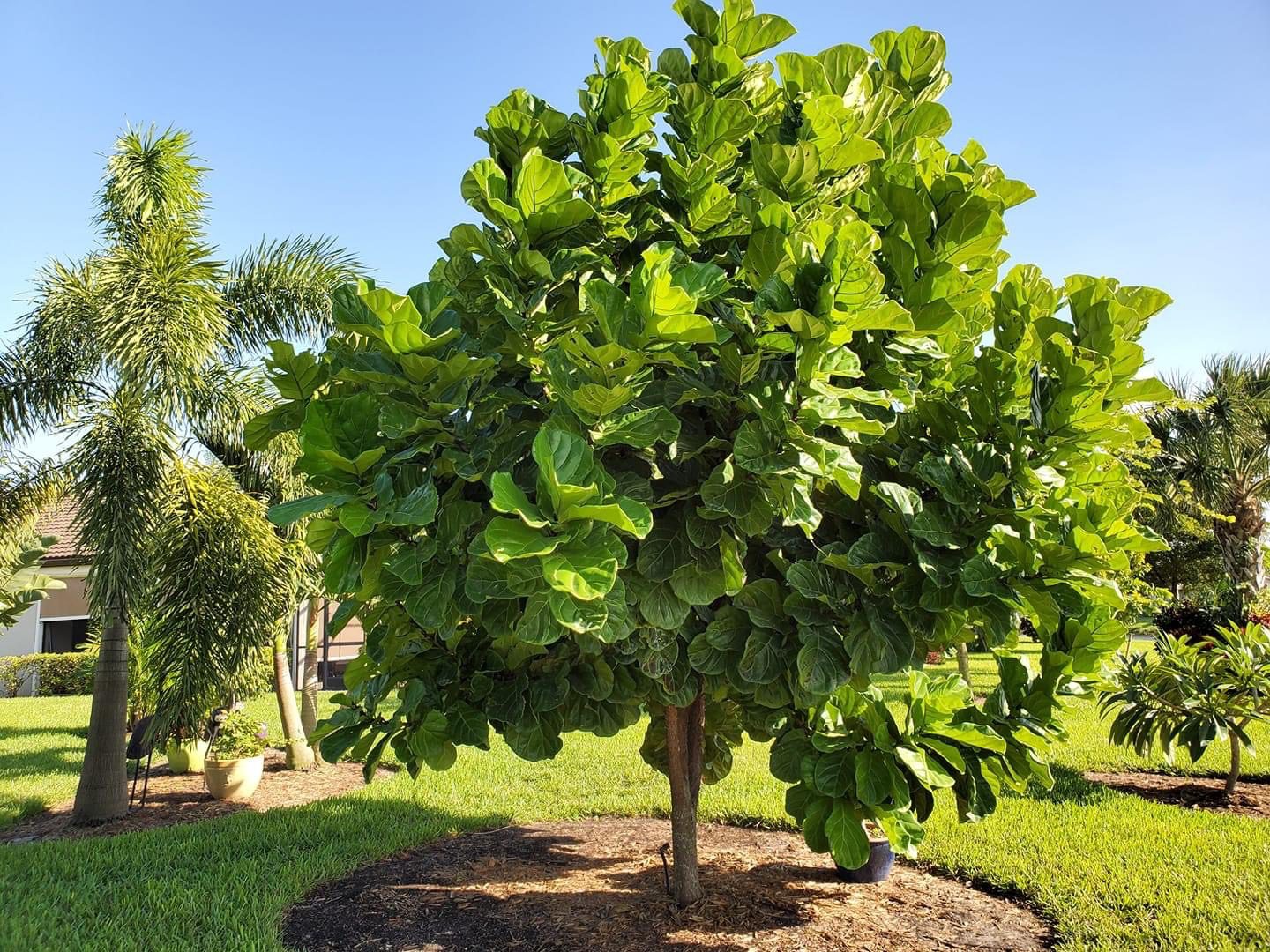Is your fiddle leaf fig plant sick? These plants can get stuck in a rut that’s hard to get them out of. Brown spots, dropping leaves, and lack of growth can be frustrating and challenging to overcome. Hold on to that plant even though you want to give up. Try one last thing: move it outside!
I recently inherited a very sick fiddle leaf fig, Clyde, that I had almost given up on. There were brown spots on almost all of the leaves, which meant they were dead from a bacterial infection. It had lost so many leaves that it looked tall and thin.
But because I love fiddle leaf figs so much, I couldn’t bear to give up my sad plant. I decided to give it one last try outside. That’s how hot it gets in San Diego. It gets around 60 degrees at night and 100 degrees during the day. In a way, the hot summer days are too warm and dry for a fiddle leaf fig, but my plant is doing great under my pergola.
As a proud fiddle leaf fig owner, you likely want to provide the very best care for your plant. And what could be better than enjoying the fresh air and sunshine of the great outdoors? Putting your fiddle leaf fig outside in summer may sound appealing, but is it truly the right move?
In this comprehensive guide, we’ll explore the pros and cons of an outdoor summer vacation for your fiddle leaf fig Read on to learn expert tips on acclimating, positioning, watering, and troubleshooting issues. With the proper precautions, your plant can thrive during its summer sojourn!
Benefits of Putting Fiddle Leaf Figs Outside
Letting your fiddle leaf fig spend time outdoors offers some potential perks:
- Increased light exposure to maximize growth
- Improved air circulation and humidity
- A break from indoor pests like spider mites
- Novelty of having your plant outdoors
- Easier watering and drainage
During the warm summer months your plant may appreciate a change of scenery on a shaded patio or front porch. Just be sure to acclimate it first and correct any underlying issues. A sick or struggling fiddle leaf fig is unlikely to improve simply from going outside.
Transitioning Your Plant Outdoors
You can’t just plunk your indoor fiddle leaf fig outside on the first sunny spring day. The shock from direct sun and wind could damage its leaves. Follow these tips to safely transition your plant:
-
Choose an area shaded from afternoon sun, such as under an awning or tree canopy.
-
Start by placing the plant outdoors for just an hour or two at a time.
-
Gradually increase the duration over 7-10 days until your plant remains outdoors full-time.
-
Mist leaves to boost humidity as your plant adapts to dry air.
-
Check frequently for sunburn, leaf curling, or distress signals.
-
Bring plants indoors immediately if temperatures drop below 50°F overnight.
With moderate daytime temperatures and protection from harsh sun and wind, your fiddle leaf fig should adjust to outdoor conditions after 7-14 days.
Caring For Your Plant Outdoors
Once settled into its outdoor home, your fiddle leaf fig will need attentive care to thrive. Monitor these factors closely:
Watering
-
Check soil moisture daily, watering when the top few inches become dry.
-
Outdoor plants dry out faster than indoor ones.
-
Tip: Use a moisture meter to determine when your plant needs water.
-
Water thoroughly until excess drains from the pot.
Sunlight
-
Ensure plant receives bright, indirect light with no direct sun.
-
Turn the pot periodically for even sun exposure.
-
Note any leaf yellowing or scorching as signs it needs more shade.
Pests
-
Check weekly for pests like spider mites or scale.
-
Summer heat and humidity encourage these plant parasites.
-
Hose down leaves to remove pests and apply neem oil if needed.
Fertilizing
-
Fertilize every 2-3 weeks with a balanced liquid fertilizer.
-
Outdoor plants grow faster due to increased light.
-
Stop fertilizing 6 weeks before bringing plant indoors.
Pruning
-
Prune off any damaged leaves or branches.
-
Pinch growing tips to encourage bushiness.
-
Hold major trimming until the plant returns indoors.
Ideal Outdoor Conditions for Fiddle Leaf Figs
To maximize success, choose an outdoor area with the following attributes:
-
Part sun or dappled shade (no direct afternoon sun)
-
Daytime temperatures from 70°F to 90°F
-
Nighttime temperatures above 50°F
-
Shelter from strong wind and rain
-
Good drainage beneath the pot
-
Relative humidity of 50% or higher
-
Transition period of 5-14 days before permanent relocation
Monitor local weather forecasts so you can bring plants indoors or provide covers during unusual cold snaps or heat waves. With ideal conditions, outdoor summering benefits healthy, established fiddle leaf figs.
Risks of Putting Fiddle Leaf Figs Outside
While enjoying summer sun and air seems beneficial, outdoor conditions also pose some risks for fiddle leaf figs:
-
Sunburn – Direct sun scorches leaves, causing brown crispy spots.
-
Wind damage – Gales or gusts can tear leaves or snap branches.
-
Temperature swings – Cold nights or hot days stress plants.
-
Dry air – Low humidity dries leaf margins without adequate moisture.
-
Underwatering – Wind and sun cause rapid water loss from pots.
-
Nutrient leaching – Frequent watering washes away soil nutrients.
-
Pests and disease – Summer weather enables infestations.
Take precautions to minimize these hazards before placing your fiddle leaf fig outdoors. Relocating a sick or weak plant often worsens problems.
Signs Your Fiddle Leaf Fig Is Struggling Outdoors
Monitor your plant closely for signals it’s not handling outdoor conditions well:
-
Wilting, drooping, or curling leaves
-
Brown crispy spots or scorched leaf edges
-
Dry, brown leaf margins
-
Increased leaf drop
-
White mineral crust on soil from rapid drying
-
Webs or tiny insects on leaves (spider mites)
-
Failure to form new leaves
-
Lack of growth or new branches
If you notice these issues, your plant likely requires more shade, humidity, or water. diagnose the problem and remedy it promptly.
Tips for a Healthy, Happy Outdoor Fiddle Leaf Fig
Follow these best practices to help your fiddle leaf fig prosper outside:
-
Acclimate plant gradually before leaving it outdoors full-time
-
Ensure pot has drainage holes to prevent wet soil issues
-
Add a thin layer of pebbles below the pot for improved drainage
-
Mist leaves in the morning to boost hydration and humidity
-
Water when top couple inches of soil become dry
-
Check for pests like spider mites every week
-
Keep leaves dust-free by wiping with damp cloth
-
Rotate pot to equalize sun exposure
-
Stop fertilizing at least 6 weeks before bringing plant indoors
-
Transition plant back indoors slowly over 7-14 days
With attentive care and ideal conditions, summering outdoors can be safe and beneficial for many fiddle leaf figs. Just take precautions when introducing significant environmental changes.
Overwintering a Fiddle Leaf Fig Outdoors
While summering outside has merits, attempting to overwinter your fiddle leaf fig outdoors is extremely risky in all but the mildest climates. These tender tropical plants suffer below 50°F and cannot tolerate frost. Some tips if you’re considering overwintering a plant outside:
-
Only attempt in frost-free zones like Southern California, Florida, or the Gulf Coast region
-
Keep plant under a patio roof or enclosed porch for cold and rain protection
-
Use frost blankets over plants during cold snaps
-
Maintain temperatures above 50°F
-
Avoid overwatering during cooler weather
-
Ensure plant enters winter dormancy by shortening day length
Even in warm zones, outdoor overwintering poses significant hazards. The safest approach is bringing fiddle leaf figs indoors before fall temperatures drop.
Troubleshooting Problems
If your fiddle leaf fig develops issues like leaf drop or spots when moved outside, here are some troubleshooting tips:
-
Sunburn – Provide more shade during afternoon sun exposure.
-
Dry leaf margins – Mist leaves often and water more frequently.
-
Wilting – Check roots for rot and improve drainage if needed.
-
Leaf drop – Reduce sunlight exposure and slowly transition indoors.
-
Few new leaves – Fertilize regularly and ensure adequate but not excessive moisture.
-
Failure to thrive – Relocate to a shadier spot with no direct sun exposure.
Closely observe how your plant responds and adjust care accordingly. Relocating outdoors works best for healthy plants under ideal conditions.
Caring For Fiddle Leaf Figs Outside in Pots
Growing fiddle leaf figs outdoors in containers carries some extra considerations:
-
Use a potting mix formulated for fiddle leaf figs like this one. It will provide the aeration and drainage these plants need.
-
go up one pot size to accommodate summer growth. Add extra perlite and orchid bark to improve drainage.
-
Weight down lightweight plastic pots so they don’t blow over in wind.
-
Keep an eye on soil moisture with a moisture meter. Outdoors, plants dry out faster.
-
Apply a thin layer of pebbles beneath the pot to prevent waterlogged soil.
-
Turn or rotate pots occasionally to equalize sun exposure for even growth.
-
Apply a water-soluble fertilizer every 2-3 weeks during the growing season.
With a bit of extra attention, container-grown fiddle leaf figs can adapt well to outdoor life in summer.
Should You Put Your Fiddle Leaf Fig Outside?
Hopefully this guide has provided a thorough overview of the potential benefits and risks of putting a fiddle leaf fig outside in summer. The key considerations are proper acclimation, ample hydration, and protection from hot sun and wind damage. A healthy plant in a shady spot can thrive with the increased sunlight and fresh air. But a struggling indoor plant is unlikely to improve simply by moving it outdoors.
Care for an Outdoor Fiddle Leaf Fig Tree
Of course, you’ll want to make sure your climate is suitable for growing a fiddle leaf fig outdoors. At night, it shouldn’t be less than 50 degrees, and during the day, it shouldn’t be more than 95 degrees.
But remember that fiddle leaf figs are very good at adapting to their surroundings! When it got up to 100 degrees this summer, my plant looked dry and sunburned, so I brought him inside for a few days. But after a month, there was another heat wave with 103-degree temperatures, so I left my plant outside. It was fine! After a few months of being outside, your fiddle leaf fig should be able to handle temperature changes that aren’t too extreme.
My fiddle leaf fig tree is in a very large ceramic pot, which provides a lot of consistency in the soil moisture. I water and feed with Fiddle Leaf Fig Plant Food once a week. If your plant is smaller, you will want to check on it at least twice a week to make sure it doesn’t dry out. (A handy moisture meter like this one can tell you when your plant is thirsty!)
Be sure to keep your plant out of direct sunlight, as they can easily burn. My plant is under a pergola and gets some direct sunlight during the day through the pergola. It seems to have done just fine in this location. When you first bring an indoor plant outside, though, you will want to keep it out of the direct afternoon sun.
Growing a Sick Fiddle Leaf Fig Plant Outdoors
There are several advantages to putting your sick fiddle leaf fig outdoors. In old medicine, they used to say that breathing fresh air could help people with lung diseases. This makes me think of that. Putting your fiddle leaf fig outside can do great things for it if you live in a climate that is good for it.
- Providing plenty of fresh air
- Increasing humidity at night
- Providing sunlight to help jump-start your plant’s immunity
- Drying out the soil to help heal the roots
- Giving you a break from the stress of a sick plant
I am astonished at how well my sick plant began growing as soon as he was outside. See the difference between the pictures of the plant before and after? It’s at least a foot taller now and has at least a dozen big, healthy new leaves! Soon, I’ll be able to cut off the old, sick leaves and have a beautiful, healthy plant.


Can Fiddle Leaf Fig Trees Take Full Sun? | Fiddle Leaf Fig Plant Resource Center
FAQ
Can I leave my fiddle leaf fig outside in the summer?
How hot is too hot for fiddle leaf fig?
Can fiddle leaf figs handle full sun?
Where is the best place to put a fiddle leaf fig?
How to grow fiddle leaf fig?
Transplant the fiddle leaf fig in a new pot with a fresh soil mix. Start slowly by moving the plant outdoors for only 3-4 hours a day. Please don’t put them under direct sunlight. Instead, put them under some shade and bring the plants inside before dusk. Increase the duration every other day by a few hours.
Can a fiddle leaf fig live outside?
Yes, a fiddle leaf fig can live outdoors, but it will require some extra care. If you live somewhere with warm winters, you can keep your fiddle leaf fig outdoors all year round. However, if you live in an area with cold winters, you will need to bring your fiddle leaf fig indoors when the temperature drops below 50 degrees.
When should I Move my Fiddle leaf fig outside?
The best time to move your fiddle leaf fig outside is during the spring and summer months. Move the plant outside when the climate of your area is warm. Summer provides the warmest months, and the plant will enjoy being outdoors during that time, given that you are not putting it under harsh afternoon sunlight.
Do fiddle leaf figs grow in winter?
Fiddle leaf figs thrive in a warm climate. Therefore, they will do well during the summer and spring months and early fall. But cold weather and low temperature are not ideal for the fiddle leaf figs. So before winter arrives, that is, by late fall, you should bring the plant inside.
- The Ultimate Guide to Growing Strawberries in Raised Beds - August 8, 2025
- No-Dig Garden Beds: The Easiest Way to Grow a Beautiful Garden - August 6, 2025
- How to Protect and Preserve Wood for Raised Garden Beds - August 6, 2025

